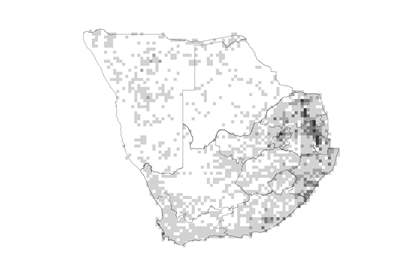 Species distribution and density. Darker squares represent higher density of members of this family. |
Introduction
Sage family
An economically important family with a wide range of uses in the medicinal, culinary and horticultural industries; also in the timber industry. Members of the family are closely related to the Scrophulariaceae.
Distribution
Cosmopolitan in warm and temperate areas and characteristic of the Mediterranean region. In southern Africa it is mainly found in the eastern and northern parts of the region.
Number of genera in the world
ca. 252
Number of species in the world
ca. 6 700
Number of genera in the Flora of southern Africa region
41
Number of species in the Flora of southern Africa region
309
Growth forms
Predominantly annual or perennial herbs, also shrubs and small to large trees and sometimes woody climbers.
Habitats
Found in almost all habitats from sea level to high altitudes and from tropical forest to the arctic tundra.
Flagship species
Leonotis leonurus (wild dagga; duiwelstabak [A]; umfincafincane [X, Z]) is a robust shrub to 3 m high. It grows in tall grassland from sea level to 2 000 m. Used in a garden to attract nectar-feeding birds, bees and butterflies. This species has a whole range of medicinal as well as various traditional folklore uses. Since the 1600s L. leonurus has been cultivated in Europe. Because of its hardiness, it is a popular garden plant in areas of South Africa that are prone to frost.
Significance of the family
Most species are aromatic and many are used as culinary herbs (e.g. sage, mint, oregano, thyme, lavender, rosemary and basil). The essential oils of *Pogostemon and *Lavandula are used in perfumes and those of *Perilla in paints. Some species have edible tubers and leaves of others are used as potherbs. Many species are grown as garden ornamentals; teak (*Tectona grandis) is an important timber hardwood. This family is a source of nectar for the honey industry. Some genera (e.g. Ajuga and Teucrium) are grown amongst crops to reduce predation by pests.
Diagnostic characters
Aromatic herbs or small shrubs. Branches 4-angled (especially when young) . Leaves simple, opposite ; pairs arranged at right angles to each other (decussate) . Stipules absent. Inflorescence with leaf-like, reduced bracts. Flowers irregular, 2-lipped ; petals 5, united; stamens 2 or 4, of unequal length, attached to corolla; ovary superior and deeply 4-lobed �; Style arising from between the lobes. Fruit comprises 4 nutlets .
Did you know?
The original family name Labiatae was given because the flowers typically have petals fused into an upper and a lower lip (Latin: labia = lips).